Motion in straight Line
1. Introduction
- In our dialy life ,we see lots of things moving around for example car passing through from one place to other ,person riding on a bicycle and many more like this.
- In scientific terms an object is said to be in motion ,if it changes its position with the pasage of time and if it does not change it position with the passage of time then it is said to be at rest
- Both the motion and rest are relative terms for example mobile kept on the table is resting at its position but it is moving in the sense as earth is rotating on its axis.So for a person seeing mobile from earth it is at rest and for person on moon earth seems to change its position with time and so mobile is moving.
- Simplest case of motion is rectilinear motion which is the motion of the object in a straight line
- In our descriotion of object ,we will treat the object as an point object
- Object under consideration can be treated as point object if the size of the object is much smaller than the distance travelled by it in a reasonable time duration for example length of a motor car travelling a distance of 500km can be neglected w.r.t distance travelled by it.
- Here in kinematics ,we study ways to describe the motion without going into the cause of the motion
2.Position and Displacement
(a) Position:
- To locate the position in motion or at rest,we need a frame of refrence.
- Simplest way to choose a frame of refrence is to choose three mutually perpendicular axis labelled as X-,Y- and Z- axis as shown in figure below
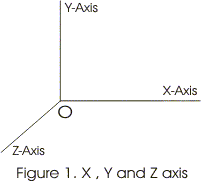
- Such system of labelling position of an object is known as rectangular coordinates system
- If A(x,y,z) be the position of any point in rectangular co-ordinates system it can be labelled as follows
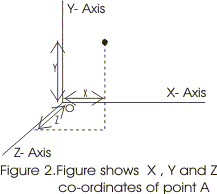
- Point O is the point of intersection of these mutaully perpendicular axis and is known as refrence point or origin of frame of refrence
- To measure a time ,we can also attach a clock with this frame of refrence
- If any or all co-ordinates of the object under consideration changes with time in this frame of refrence then the object is said to be in a motion w.r.t the frame of the refrence otherwise it is at rest
- For describing motion in one dimension we need one set of co-ordinates axis i.e only one of X,Y and Z axis
- Similary for two and three dimensions we need two or three set of axis respectively
- Motion of an object along a straight line is an example of motion in one dimension
- For such a motion,any one axis say X-axis may be choosen so as to co-incide with the path along which object is moving
- Position of the object can be measured w.r.t origin O shown in the figure

- Position to the right of the origin has positive values and those to the left of origin O has negative values.
(b) Distance and displacement:
- In the graph shown below an object is at position P at time t1 and at position R at time t2.
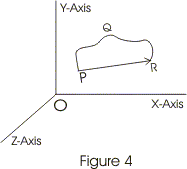
- In the time interval from t1 to t2 particle has travelled path PQR and length of the path PQR is the distance travelled by the object in the time interval t1 to t2
- Now connect the initial position of the object P with its final position R through a straight line and we get the displacement of the object.
- Displacement of the object has both magnitude and direction i.e., displacement is a vector quantity.
- Magnitude of displacement vector is equal to the length of straight line joining initial and final position and its directionpoints from the initial position of object towards its final position.
- In contrast to displacement distance is scalar quantity.
3. Average velocity and speed
- Consider a particle undergoing motion along a straight line i.e. moving along X-axis.
- X co-ordinate describing motion of the particle from origin O varies with time or we can say that X co-ordinate depends on time.
- If at time t=t1 particleis at point P , at a distance x1 from origin and at time t=t2 it is at point Q at a distance x2 from the origin then displacement during this time is a vector from point P to Q and is
Δx=x2-x1 (1)
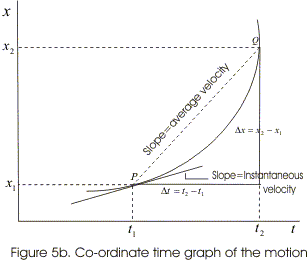
- The average velocity of the prticle is defined as the ratio of the displacement Δx of the particle in the time interval Δt=t2-t1. If vavg represents average velocity then,

- Figure 5b represents the co-ordinate time graph of the motion of the particle i.e., it shows how the value of x-coordinate of moving particle changes with the passage of time.
- In figure 5b average velocity of the particle is represented by the slope of chord PQ which is equal to the ratio of the displacement Δx occuring in the particular time interval Δt.
- Like displacement average velocity vavg also has magnitude as well as direction i.e., average velocity is a vector quantity.
- Average velocity of the particle can be positive as well as negative and its positive and negative value depends on the sign of displacement.
- If displacement of particle is zero its average velocity is also zero.
- Graphs below shows the x-t graphs of particle moving with positive, negative average velocity and the particle at rest.
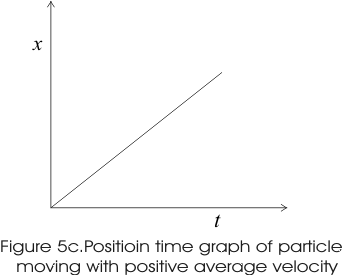
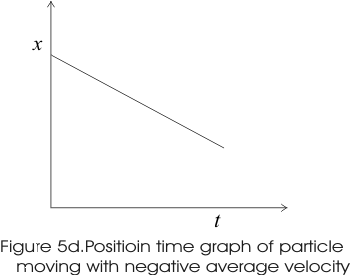
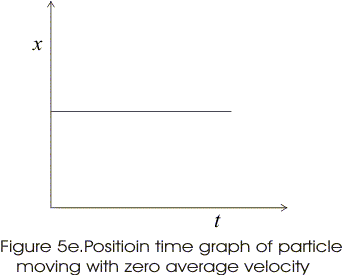
- From graph 5c it is clear that for positive average velocity slope of line slants upwards right or we can say that it has positive slope.
- For negative average velocity slope line slants upwards down to the right i.e. it has negative slope.
- For particles at rest slope is zero.
- So far we have learnt that average speed is the rate of motion over displacement of the object.
- Displacement of the object is different from the actual distance travelled by the particle.
- For actual distance travelled by the particle its average speed is defined as the total distance travelled by the particle in the time interval during which the motion takes place.
- Mathematically,

- Since distance travelled by an particle does not involve direction so speed of the particle depending on distance travelled does not involve direction and hence is a scalar quantity and is always positive.
- Magnitude of average speed may differ from average velocity because motion in case of average speed involve distance which may be greater than magnitude of displacement for ex.
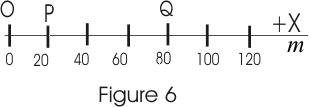
here a man starts travelling from origin till point Q and return to point P then in this case displacement of man is
Displacement from O to Q is OQ=80m
Displacement from Q to P is =20m-80m=-60m
total displacement of particle in moving from O to Q and then moving Q to P is = 80m + (-60m) = 20 m
Now total distance travelled by man is OQ+OP= 80m +60m = 140m
Hence diring same cource of motion distance travelled is greater then displacement. - from this we can say that average speed depending on distance is in general greater than magnitude of velocity.
4. Instantaneous velocity and speed
- Velocity of particle at any instant of time or at any point of its path is called instantaneous velocity.
- Again consider the graph 5b and imagine second point Q being taken more and more closer to point P then calculate the average velocity over such short displacement and time interval.
- Instantaneous velocity can be defined as limiting value of average velocity when second point comes closer and closer to the first point.
- Limiting value of Δx/ Δt as Δt aproaches zero is written as dx/dt, and is known as instantaneous velocity.Thus instantaneous velocity is

- As point Q aproaches point P in figure 5a in this limit slope of the chord PQ becomes equal to the slope of tangent to the curve at point P.
- Thus we can say that instantaneous velocity at any point of a coordinate time graph is equal to the slope of the tangent to the graph at that point.
- Instantaneous speed or speed is the magnitude of the instantaneous velocity unlike the case of average velocity and average speed where average speed over an finite interval of time may be greate than or equal to average velocity.
- Unit of average velocity , average speed, instantaneous velocity and instantaneous speed is ms-1 in SI system of units.
- Some other units of velocity are ft.s-1 , cm.s-1 .
5. Acceleration
- Acceleration is the rate of change of velocity with time.
- For describing average acceleration we first consider the motion of an object along X-axis.
- Suppose at time t1 object is at point P moving with velocity v1 and at time t2 it is at point Q and has velocity v2. Now average acceleration of object in moving from P to Q is

which is the change in velocity of object with the passage of time. - Instantaneous acceleration can be defined in the same way as instantaneous velocity

- The instantaneous acceleration at any instant is the slope of v-t graph at that instant.
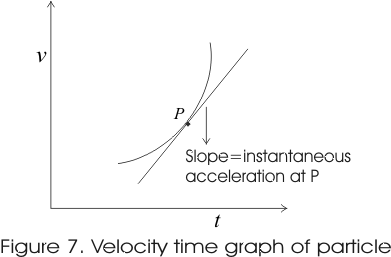
- In figure 7 instantaneous acceleration at point P is equal to the slope of tangent at this point P.
- Since velocity of a moving object has both magnitude and direction likewise acceleration depending on velocity has both magnitude and direction and hence acceleration is a vector quantity.
- Acceleration can also be positive, negative and zero.
- SI unit of acceleration is ms-2
6. Motion with constant acceleration
- Motion with constant acceleration or uniformly accelerated motion is that in which velocity changes at the same rate troughout motion.
- When the acceleration of the moving object is constant its average acceleration and instantaneous acceleration are equal. Thus from eq. 5 we have

- Let v0 be the velocity at initial time t=0 and v be the velocity of object at some other instant of time say at t2=t then above eq. 7 becomes

or , v=v0+at (8) - Graphically this relation is represented in figure 8 given below.
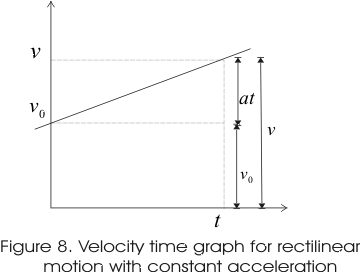
- Thus from the graph it can be seen clearly that velocity v at time t is equal to the velocity v0 at time t=0 plus the change in velocity (at).
- In the same way average velocity can be written as

where x0 is the position of object at time t=0 and vavg is the averag velocity between time t=0 to time t.The above equation then gives
x=x0+vavgt (9)
but for the interval t=0 to t the average velocity is
Now from eq. 8 we find
vavg = v0 + ½(at) (11)
putting this in eq. 9 we find
x = x0 + v0t + ½(at2)
or,
x - x0 = v0t + ½(at2) (12)
this is the position time relation for object having uniformly accelerated motion. - From eq. 12 it is clear that an object at any time t has quadratic dependance on time, when it moves with constant acceleration along a straight line and x-t graph for such motion will be parabolic in natureas shown below.
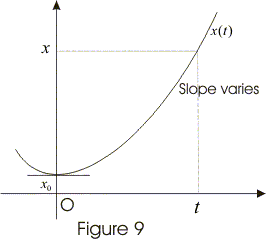
- Equation 8 and 12 are basic equations for constant acceleration and these two equations can be combined to get yet another relation for x , v and a eleminating t so, from 8

putting this value of t in equation 12 and solving it we finally get,
v2 = (v0)2 + 2a ( x - x0 ) (13) - Thus from equation 13 we see that it is velocity displacement relation between velocities of object moving with constant acceleration at time t and t=0 and their corresponding positions at these intervals of time.
- This relation 13 is helpful when we do not know time t.
- Likewise we can also eliminate the acceleration between equation 8 and 12. Thus from equation 8

putting this value of a in equation 12 and solving it we finally get,
( x - x0 ) = ½ ( v0 + v ) t (14) - Same way we can also eliminate v0 using equation 8 and 12. Now from equation 8
v0 = v - atputting this value of v0 in equation 12 and solving it we finally get,
( x - x0 ) = vt + ½ ( at2 ) (15)
thus equation 15 does not involve initial velocity v0 - Thus these basic equations 8 and 12 , and derived equations 13, 14, and 15 can be used to solve constant acceleration problems.
7. Free fall acceleration
- Freely falling motion of any body under the effect of gravity is an example of uniformly accelerated motion.
- Kinematic equation of motion under gravity can be obtained by replacing acceleration 'a' in equations of motion by acceleration due to gravity 'g'.
- Value of g is equal to 9.8 m.s-2.
- Thus kinematic equations of motion under gravity are
v = v0 + gt (16a)
x = v0t + ½ ( gt2 ) (16b)
v2 = (v0)2 + 2gx (16c) - The value of g is taken positive when the body falls vertically downeards and negative when the body is projected up against gravity.
8. Relative velocity
- Consider two objects A and B moving with uniform velocities vAand vB along two straight and parallel tracks.
- Let xOAand xOB be their distances from origin at time t=0 and xAand xB be their distances from origin at time t.
- For object A
xA = xOA + vAt (18)
and for object B
xB = xOB + vBt (19)
subtracting equation 18 from 19
xB - xA = ( xOB - xOA ) + ( vB - vA) t (20) - Above equation 20 tells that as seen from object A , object B seems to have velocity ( vB - vA) .
- Thus ( vB - vA ) is the velocity of object B relative to object A. Thus,
vBA = ( vB - vA ) (21) - Similarly velocity of object A relative to object B is
vAB = ( vA - vB ) (22) - If vB = vA then from equation 20
xB - xA = ( xOB - xOA )
i.e., two objects A and B stays apart at constant distance. - vA > vB then (vB - vA ) would be negative and the distance between two objects will go on decreasing by an amount ( vA- vB ) after each unit of time. After some time they will meet and then object A will overtake object B.
- If vA and vB have opposite signs then magnitude of vBA or vAB would be greater then the magnitude of velocity of A or that of B and objects seems to move very fast
Solved Examples Part 1
Question 1.
A ball is dropped vertically from a height h above the ground .It hits the ground and bounces up vertically to a height h/2.Neglecting subsequent motion and air resistance ,its velocity v varies with the height h as
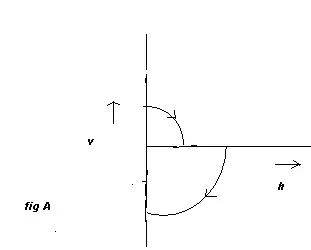
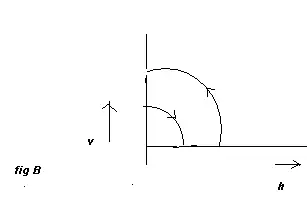
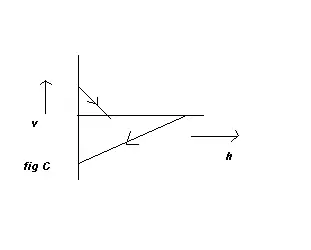
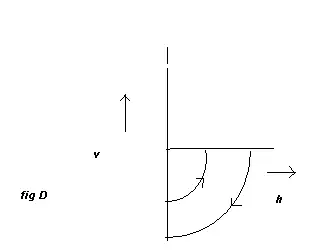
Solution(1):
. Before hitting the ground ,the velocity v is given by v2=2gd Which is a quadratic equation and hence parabolic path. Downward direction means negative velocity , After collison ,the velocity becomes positive and velocity decreases Further v12=2g(d/2)=gd Therefore v=v1√2 As the direction is reversed and speed is decreased, Hence (a) is the answer
Question 2. The displacement -time graph of a moving particle is shown below.The instantanous velocity of the particle is negative at the point
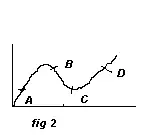
a. C
b. D
c. E
d. B
Solution(2):
. The instantanous velocity is given by the slope of the displacement time graph.
Since slope is negative at point B,instantanous velocity is negative at B
Hence (d) is correct




Solution(1):
. Before hitting the ground ,the velocity v is given by v2=2gd Which is a quadratic equation and hence parabolic path. Downward direction means negative velocity , After collison ,the velocity becomes positive and velocity decreases Further v12=2g(d/2)=gd Therefore v=v1√2 As the direction is reversed and speed is decreased, Hence (a) is the answer
Question 2. The displacement -time graph of a moving particle is shown below.The instantanous velocity of the particle is negative at the point

a. C
b. D
c. E
d. B
Solution(2):
. The instantanous velocity is given by the slope of the displacement time graph.
Since slope is negative at point B,instantanous velocity is negative at B
Hence (d) is correct
Question 3.
The velocity -time graph of a moving particle is shown below.Total displacement of the particle during the time interval when there is nonzero acceleration and retardation is
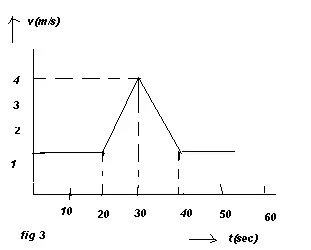
a. 60m
b. 40m
c. 50m
d. 30m
Solution(3):
. Acceleration is given by the slope of the velocity time graph
Non zero acceleration happened in the time interval 20 to 40 sec as the slope of the graph is non zero in that time interval
Now displacement in that interval is given by the area enclosed the v-t curve during that interval
So area=(1/2)20*3 +20*1=50m
Hence (c) is correct
Question 4. Figure below shows the displacement -time graph of two particles.Mark the correct statement about their relative velocity
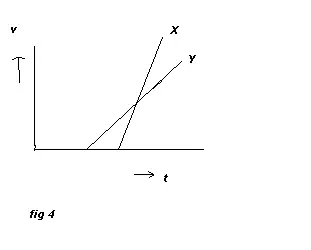
a. It first increases and then decreases
b. It is a non zero constant
c. it is zero
d. none of the above
Solution(4):
. The instantanous velocity is given by the slope of the displacement time graph.
As slope of both the particle displacement time graph is constant.That means there individual velocities are constant.
So relative velocity is also constants
so it is a non zero constant as they have different velocity
Hence (b) is correct

a. 60m
b. 40m
c. 50m
d. 30m
Solution(3):
. Acceleration is given by the slope of the velocity time graph
Non zero acceleration happened in the time interval 20 to 40 sec as the slope of the graph is non zero in that time interval
Now displacement in that interval is given by the area enclosed the v-t curve during that interval
So area=(1/2)20*3 +20*1=50m
Hence (c) is correct
Question 4. Figure below shows the displacement -time graph of two particles.Mark the correct statement about their relative velocity

a. It first increases and then decreases
b. It is a non zero constant
c. it is zero
d. none of the above
Solution(4):
. The instantanous velocity is given by the slope of the displacement time graph.
As slope of both the particle displacement time graph is constant.That means there individual velocities are constant.
So relative velocity is also constants
so it is a non zero constant as they have different velocity
Hence (b) is correct
Four position -time graph are shown below.
a.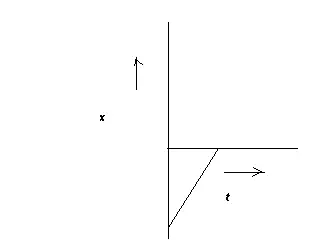
b.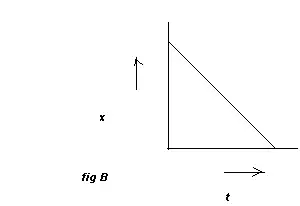
c.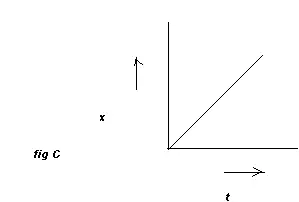
d.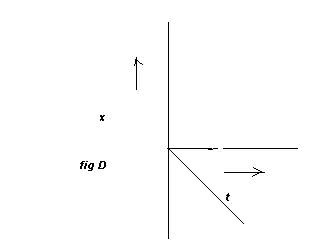
Question 5 What all graph shows motion with positive velocities
a. a and c only
b. all the four
c. b and D only
d. b only
Solution(5):
. The instantanous velocity is given by the slope of the displacement time graph.
Since slope is positive in graph a and c.Positive velocity is there in a and c curve
Hence (a) and (c) are correct
a.

b.

c.

d.

Question 5 What all graph shows motion with positive velocities
a. a and c only
b. all the four
c. b and D only
d. b only
Solution(5):
. The instantanous velocity is given by the slope of the displacement time graph.
Since slope is positive in graph a and c.Positive velocity is there in a and c curve
Hence (a) and (c) are correct
Question 6.
What all graph shows motion with negative velocities
a. a and b only
b. all the four
c. a and c only
d. c only
Solution(6):
. The instantanous velocity is given by the slope of the displacement time graph.
Since slope is negative in graph b and d.Negative velocity is there in b and d curve
Hence (b) and (d) are correct
Question 7.which of the folliwing graph correctly represents velocity-time relationships for a particle released from rest to fall under gravity
a.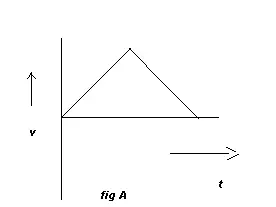
b.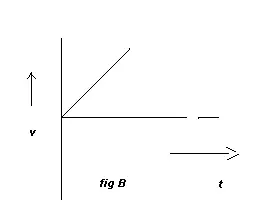
c.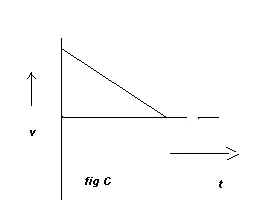
d.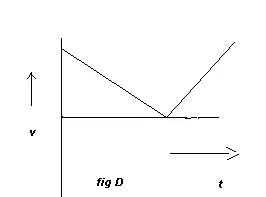
Solution(7):
.
The velocity will increase with time so b is the correct answer
Hence (b) is correct
Question 8.The v-x graph of a particle moving along a straight line is shown below.Which of the below graph shows a-x graph
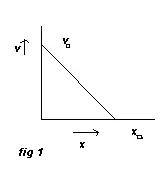
a.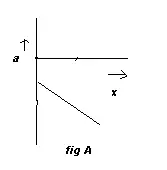
b.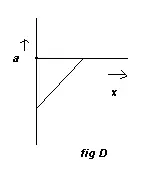
c.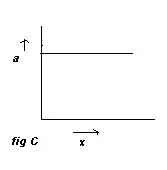
d.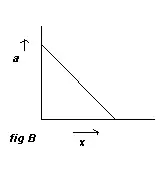
Solution(8):
. The equation for the given graph is
v=-(v0/x0)x + v0 ---(1)
Differentiating both sides we get
dv/dx=-v0/x0 ---(2)
Now
a=v(dv/dx)
or
a=(-v0/x0)[-(v0/x0)x + v0 ]
or
a=mx+c
where m=v02/x0)2
and c=-v02/x0)2
So that means slope is positive and intercept is negative
So (d) is correct
a. a and b only
b. all the four
c. a and c only
d. c only
Solution(6):
. The instantanous velocity is given by the slope of the displacement time graph.
Since slope is negative in graph b and d.Negative velocity is there in b and d curve
Hence (b) and (d) are correct
Question 7.which of the folliwing graph correctly represents velocity-time relationships for a particle released from rest to fall under gravity
a.

b.

c.

d.

Solution(7):
.
The velocity will increase with time so b is the correct answer
Hence (b) is correct
Question 8.The v-x graph of a particle moving along a straight line is shown below.Which of the below graph shows a-x graph

a.

b.

c.

d.

Solution(8):
. The equation for the given graph is
v=-(v0/x0)x + v0 ---(1)
Differentiating both sides we get
dv/dx=-v0/x0 ---(2)
Now
a=v(dv/dx)
or
a=(-v0/x0)[-(v0/x0)x + v0 ]
or
a=mx+c
where m=v02/x0)2
and c=-v02/x0)2
So that means slope is positive and intercept is negative
So (d) is correct
Question 9.
A truck accelerates from rest at the constant rate a for some time after which it decelerates at a constant rate of b to come to the rest.If the total time elapsed is t ,then find out the maximum velocity attains by the truck
a. (ab/a+b)t
b.(a+b/ab)t
c. (a2+b2/ab)t
d.(a2-b2/ab)t
Solution(9):
. Let t1 and t2 be the the time for acceleration and deccleration.
Let v be the maximum velocity attained
Then
v=at1 or t1=v/a
v=bt2 or t2=v/b
Now t=t1 + t2
or t=v/a + v/b
or v=abt/(a+b)
Hence (a) is correct
Question 10.Displacement(y) of the particle is given by
y=2t+t2-2t3
The velocity of the particle when acceleration is zero is given by
a. 5/2
b. 9/4
c. 13/6
d. 17/8
Solution(10):
. given
y=2t+t2-2t3
Velocity is given
v=dy/dt=2+2t-6t2
a=dv/dt=2-12t
Now acceleratio is zero
2-12t=0
t=1/6
Putting this value velocity equation
v=2+2/6-6(1/6)2
=2+1/3-1/6
=13/6
Hence (c) is correct
Question 11.Mark out the correct statement
a. Instantaneous Velocity vector is always in the direction of the motion
b. Instantaneous acceleration vector is always in the direction of the motion
c. Acceleration of the moving particle can change its direction without any change in direction of velocity
d. None of the above
Solution(11):
. Take the case of uniform circular motion,Instantanous Velocity vector and acceleration vector at any point is tangent and radial to the circle.So it is not along the direction of the circle
Take the case the moving car in one direction.If the car accelerated,acceleration is along the direction of velocity.if car driver put a brake then it deacclerates without any change in the direction of the velocity
Hence (c) is correct
a. (ab/a+b)t
b.(a+b/ab)t
c. (a2+b2/ab)t
d.(a2-b2/ab)t
Solution(9):
. Let t1 and t2 be the the time for acceleration and deccleration.
Let v be the maximum velocity attained
Then
v=at1 or t1=v/a
v=bt2 or t2=v/b
Now t=t1 + t2
or t=v/a + v/b
or v=abt/(a+b)
Hence (a) is correct
Question 10.Displacement(y) of the particle is given by
y=2t+t2-2t3
The velocity of the particle when acceleration is zero is given by
a. 5/2
b. 9/4
c. 13/6
d. 17/8
Solution(10):
. given
y=2t+t2-2t3
Velocity is given
v=dy/dt=2+2t-6t2
a=dv/dt=2-12t
Now acceleratio is zero
2-12t=0
t=1/6
Putting this value velocity equation
v=2+2/6-6(1/6)2
=2+1/3-1/6
=13/6
Hence (c) is correct
Question 11.Mark out the correct statement
a. Instantaneous Velocity vector is always in the direction of the motion
b. Instantaneous acceleration vector is always in the direction of the motion
c. Acceleration of the moving particle can change its direction without any change in direction of velocity
d. None of the above
Solution(11):
. Take the case of uniform circular motion,Instantanous Velocity vector and acceleration vector at any point is tangent and radial to the circle.So it is not along the direction of the circle
Take the case the moving car in one direction.If the car accelerated,acceleration is along the direction of velocity.if car driver put a brake then it deacclerates without any change in the direction of the velocity
Hence (c) is correct
Matrix match type
Question 12.In a free fall motion from rest,Match column I to column II
column I
A) Graph between displacement and time
B) Graph between velocity and time
C) Graph between velocity and displacement
D) Graph between KE and displacement
column II
P) Parabola
Q) Straight line
C) Circle
D) No appropiate match given
Solution(12):
. Equation of motion for a free fall from rest
x=(1/2)gt2.It is a parabola
v=gt it is a straight line
v2=2gx it is a parabola
KE=(1/2)mv2=mgx..... it is a straight line
So the correct answers are A -> P
B -> Q
C -> P
D -> Q
Question 12.In a free fall motion from rest,Match column I to column II
column I
A) Graph between displacement and time
B) Graph between velocity and time
C) Graph between velocity and displacement
D) Graph between KE and displacement
column II
P) Parabola
Q) Straight line
C) Circle
D) No appropiate match given
Solution(12):
. Equation of motion for a free fall from rest
x=(1/2)gt2.It is a parabola
v=gt it is a straight line
v2=2gx it is a parabola
KE=(1/2)mv2=mgx..... it is a straight line
So the correct answers are A -> P
B -> Q
C -> P
D -> Q

No comments:
Post a Comment